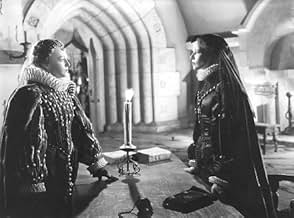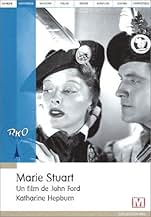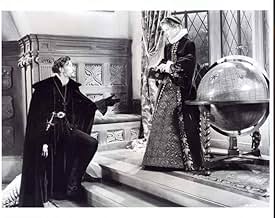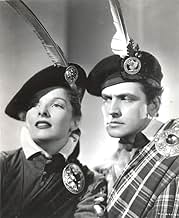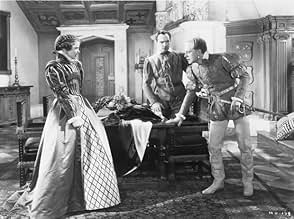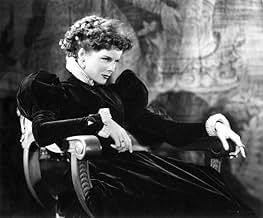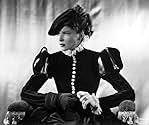CALIFICACIÓN DE IMDb
6.3/10
2.9 k
TU CALIFICACIÓN
La recientemente viuda Mary Stuart regresa a Escocia para reclamar su trono, pero se opone a su medio hermano y sus propios señores escoceses.La recientemente viuda Mary Stuart regresa a Escocia para reclamar su trono, pero se opone a su medio hermano y sus propios señores escoceses.La recientemente viuda Mary Stuart regresa a Escocia para reclamar su trono, pero se opone a su medio hermano y sus propios señores escoceses.
- Dirección
- Guionistas
- Elenco
- Premios
- 3 premios ganados y 1 nominación en total
- Dirección
- Guionistas
- Todo el elenco y el equipo
- Producción, taquilla y más en IMDbPro
Opiniones destacadas
Katharine Hepburn plays the young queen in this John Ford version of the rivalry between Mary of Scots and her cousin, Elizabeth I (played by Florence Eldridge; whose husband Fredric March plays a jaunty Lord Bothwell). Cut back to the bare bones, and squarely on the differences between the two women, it isn't altogether successful.
John Knox rants his Protestant spiel, Bothwell appears with a retinue of pipers (at several points); Darnley's murder is glossed over, as is his smallpox. John Carradine has a well-defined role as the ill-fated David Rizzio, while Mary's parasitical court of Lords are quirkily represented and dismissed.
Hepburn isn't as bad as one would fear, but it wasn't really a suitable role for her, nor, one would expect, was the material enough for tough director Ford to make much of. So this film remains a misfire, with some interesting sequences and some strong performances, but as a whole, it just doesn't work.
John Knox rants his Protestant spiel, Bothwell appears with a retinue of pipers (at several points); Darnley's murder is glossed over, as is his smallpox. John Carradine has a well-defined role as the ill-fated David Rizzio, while Mary's parasitical court of Lords are quirkily represented and dismissed.
Hepburn isn't as bad as one would fear, but it wasn't really a suitable role for her, nor, one would expect, was the material enough for tough director Ford to make much of. So this film remains a misfire, with some interesting sequences and some strong performances, but as a whole, it just doesn't work.
Don't let my summary get you upset, I would never mean to do that--but although I do love this film--in short it is a bit boring. I loved the period costumes and sets and the acting, but the storyline lacked any real excitement!! Hepburn was fine but any real passion in the acting department has to go to Fredric March. The supporting players were also very good in their parts, especially Florence Eldridge as Queen Elizabeth. I saw somewhere that Ginger Rogers tried out secretly for the role of Elizabeth and almost had it until she was found out by the director!! Would have loved to have seen that one--LOL But it is a nice film, but just a tad too long and boring!!
The life story of Mary, Queen of Scots is a thoroughly engaging one. I recommend anyone who wants to know more about the history while being entertained at the same time to check out the two Jean Plaidy books, ROYAL ROAD TO FOTHERINGAY and its sequel, THE CAPTIVE QUEEN OF SCOTS - two great little novels that tell you all there is to know.
MARY OF Scotland is an all-too Hollywoodised version of the story that suffers from an exceptionally overlong running time, unfortunately. It's strange, because some parts of the production are exceptionally slow and boring, while 19 years of history is condensed into about five minutes. There are a few eventful bits but for the most part this is a drag.
The director is none other than John Ford, but despite the presence of such a cinematic luminary, he seems uninterested in the material which is lifeless as a result. Katharine Hepburn is also a disappointment as Mary herself, singularly failing to make the queen sympathetic in any way. Fredric March does what he can as Bothwell, and there are nice little roles for John Carradine and Moroni Olsen, but it's not enough.
I particularly disliked the way that some good little bits of history are omitted or simplified for no apparent reason. For instance, Douglas Walton's final scene didn't happen that way at all and much more drama could have been made of it. Instead all the focus is on the talk and its incessant and goes nowhere. The definitive story of Mary, Queen of Scots this certainly isn't.
MARY OF Scotland is an all-too Hollywoodised version of the story that suffers from an exceptionally overlong running time, unfortunately. It's strange, because some parts of the production are exceptionally slow and boring, while 19 years of history is condensed into about five minutes. There are a few eventful bits but for the most part this is a drag.
The director is none other than John Ford, but despite the presence of such a cinematic luminary, he seems uninterested in the material which is lifeless as a result. Katharine Hepburn is also a disappointment as Mary herself, singularly failing to make the queen sympathetic in any way. Fredric March does what he can as Bothwell, and there are nice little roles for John Carradine and Moroni Olsen, but it's not enough.
I particularly disliked the way that some good little bits of history are omitted or simplified for no apparent reason. For instance, Douglas Walton's final scene didn't happen that way at all and much more drama could have been made of it. Instead all the focus is on the talk and its incessant and goes nowhere. The definitive story of Mary, Queen of Scots this certainly isn't.
The directors cannot refrain from showing the two queens together in one scene.Charles Jarrot -whose movie is inferior to John Ford's- did the same in 1972.And however,they never met ,not a single time during Mary's captivity.But John Ford's scene is useful for people who know little about the Virgin Queen.It's sure that Mary's childhood in France was a nice one even though her reign was short as king François II's wife.On the other hand,Elizabeth lived in fear when she was a child for her bloody sister wanted to get rid of her.
The first past begins in Scotland ,and France is only evoked in Mary's memories.This first part is the most satisfying historically speaking:Darnley's and Ricci's murders are well directed by Ford,and the town criers who ,every ten minutes announce "It's eight'o clock!All is fine!" shows his sense of humor.Biggest flaw is the little part of James Stuart, aka"the bastard" aka Maurey:This man is really the stringman,who plays a prominent part in the queen's downfall,holding Mary like a puppet on a string,travelling to France when rebellion begins -he was not here when Mary was imprisoned in Lochleven-,just coming back to reap the benefits (regency he had lost when his sister came back).
Frederic March is a fine actor,but his Bothwell is not credible.Bothwell was a hairy brute ,not the romantic chivalrous fair knight we see here.Mary's abduction remains a mysterious part because the historians have no documents of what really happened.Mary's captivity in Lochleven-where she at last understood how James Stuart fooled her -and her extraordinary escape -worthy of Hitchcock's suspense-lasts barely 30 seconds on the screen.
Ditto for Mary's captivity in England.When she arrived,she was in what we would call "under house arrest" today.Only during her last year,when they discovered a plot,she was taken to the fortress of Fotheringay (a wonderful Fairport Convention song by the way),she was really a prisoner in the modern sense of the term.And she had a whole floor for herself though.
The trial is unsatisfying.At the time,Mary did not care for Bothwell anymore,she was longing to become a martyr of the Catholic cause.She did not know that the pope did not take her seriously .The scene with Donald is pure romantic fiction.
All in all ,and even if the things fall apart a bit in the second part,the movie is magnificently enhanced by Hepburn's presence and Ford -they said they had a love affair on the set- lovingly films her.I've been told that the scene between Bothwell and the queen on the tower was filmed by KH herself.
The first past begins in Scotland ,and France is only evoked in Mary's memories.This first part is the most satisfying historically speaking:Darnley's and Ricci's murders are well directed by Ford,and the town criers who ,every ten minutes announce "It's eight'o clock!All is fine!" shows his sense of humor.Biggest flaw is the little part of James Stuart, aka"the bastard" aka Maurey:This man is really the stringman,who plays a prominent part in the queen's downfall,holding Mary like a puppet on a string,travelling to France when rebellion begins -he was not here when Mary was imprisoned in Lochleven-,just coming back to reap the benefits (regency he had lost when his sister came back).
Frederic March is a fine actor,but his Bothwell is not credible.Bothwell was a hairy brute ,not the romantic chivalrous fair knight we see here.Mary's abduction remains a mysterious part because the historians have no documents of what really happened.Mary's captivity in Lochleven-where she at last understood how James Stuart fooled her -and her extraordinary escape -worthy of Hitchcock's suspense-lasts barely 30 seconds on the screen.
Ditto for Mary's captivity in England.When she arrived,she was in what we would call "under house arrest" today.Only during her last year,when they discovered a plot,she was taken to the fortress of Fotheringay (a wonderful Fairport Convention song by the way),she was really a prisoner in the modern sense of the term.And she had a whole floor for herself though.
The trial is unsatisfying.At the time,Mary did not care for Bothwell anymore,she was longing to become a martyr of the Catholic cause.She did not know that the pope did not take her seriously .The scene with Donald is pure romantic fiction.
All in all ,and even if the things fall apart a bit in the second part,the movie is magnificently enhanced by Hepburn's presence and Ford -they said they had a love affair on the set- lovingly films her.I've been told that the scene between Bothwell and the queen on the tower was filmed by KH herself.
Mary of Scotland (1935)
** 1/2 (out of 4)
Historical drama from RKO about the rivalry between Mary of Scots (Katharine Hepburn) and her cousin Elizabeth I (Florence Eldridge). The film follows Mary's fight for justice from 1560 to 1587 and includes her third marriage to Bothwell (Fredric March). This film was a notorious flop when it was originally released and it had a large part in Hepburn being called box office poison. Seeing the film today it's rather amazing to see how good the film actually looks considering RKO was usually just popping out very low-budget films. There were certainly a few exceptions and this here is one of them and I'm sure many will be shocked to see how much actually went into this film. The amazing sets and costumes are one of the biggest selling points to the movie. Ford knows how to make things appear epic and he does that here with these amazing sets that make you feel as if you're at the actual locations. Many times these sets are obviously on some lot but you never get that feeling here. The costumes are another major plus as they help bring a realistic nature to the film. I'm not sure what the actual budget was on the film but it really does look just as expensive as many of de Mille's epics. Another reason the film is worth viewing is the performance by Hepburn. As a devoted atheist she really does a nice job in the role of a Catholic and her religious scenes are quite moving as she's certainly giving it her all. She's very believable in the part as you can tell she's strong enough to lead all the battles that Mary had to. That strong nature of the actress clearly shows up on the screen. March is also very good in his role, although the film could have used much more of him. I was a little Luke warm on Eldridge but after a while she started to grow on me. The supporting cast includes Douglas Walton, Frieda Inescourt, Donald Crisp and John Carradine. Carradine plays the servant Rizzo and does a pretty good job with it. We also get to hear him sing a couple songs, which I'm not sure how many times he had the chance of doing that in his long career. The biggest problem with the movie is that the story is at times hard to follow as it appears like the screenplay wasn't totally sure where they wanted to take all of the events. I think at times the story just seemed to float all over the place.
** 1/2 (out of 4)
Historical drama from RKO about the rivalry between Mary of Scots (Katharine Hepburn) and her cousin Elizabeth I (Florence Eldridge). The film follows Mary's fight for justice from 1560 to 1587 and includes her third marriage to Bothwell (Fredric March). This film was a notorious flop when it was originally released and it had a large part in Hepburn being called box office poison. Seeing the film today it's rather amazing to see how good the film actually looks considering RKO was usually just popping out very low-budget films. There were certainly a few exceptions and this here is one of them and I'm sure many will be shocked to see how much actually went into this film. The amazing sets and costumes are one of the biggest selling points to the movie. Ford knows how to make things appear epic and he does that here with these amazing sets that make you feel as if you're at the actual locations. Many times these sets are obviously on some lot but you never get that feeling here. The costumes are another major plus as they help bring a realistic nature to the film. I'm not sure what the actual budget was on the film but it really does look just as expensive as many of de Mille's epics. Another reason the film is worth viewing is the performance by Hepburn. As a devoted atheist she really does a nice job in the role of a Catholic and her religious scenes are quite moving as she's certainly giving it her all. She's very believable in the part as you can tell she's strong enough to lead all the battles that Mary had to. That strong nature of the actress clearly shows up on the screen. March is also very good in his role, although the film could have used much more of him. I was a little Luke warm on Eldridge but after a while she started to grow on me. The supporting cast includes Douglas Walton, Frieda Inescourt, Donald Crisp and John Carradine. Carradine plays the servant Rizzo and does a pretty good job with it. We also get to hear him sing a couple songs, which I'm not sure how many times he had the chance of doing that in his long career. The biggest problem with the movie is that the story is at times hard to follow as it appears like the screenplay wasn't totally sure where they wanted to take all of the events. I think at times the story just seemed to float all over the place.
¿Sabías que…?
- TriviaKatharine Hepburn credited John Ford with saving her life one day on the set. They were shooting a scene of Hepburn on horseback when the horse she was riding kept going unexpectedly. Ford yelled at Hepburn to duck just before she was about to collide with a low branch.
- ErroresMary's execution takes place outdoors. It actually took place in the great hall of Fotheringay Castle.
- Citas
Mary, Queen of Scots: [to Queen Elizabeth I] I might have known you'd come to gloat like this - stealthily, under cover of night.
- Créditos curiososOpening credits: "Like two fateful stars, Mary Stuart and Elizabeth Tudor appeared in the sixteenth century, to reign over two great nations in the making ... They were doomed to a life-and-death struggle for supremacy, a lurid struggle that still shines across the pages of history ... But today, after more than three centuries, they sleep side by side, at peace, in Westminster Abbey."
ENGLAND
- Versiones alternativasExists in a computer-colorized version.
- ConexionesFeatured in The Costume Designer (1950)
Selecciones populares
Inicia sesión para calificar y agrega a la lista de videos para obtener recomendaciones personalizadas
Detalles
- Fecha de lanzamiento
- País de origen
- Idioma
- También se conoce como
- Mary of Scotland
- Locaciones de filmación
- Productora
- Ver más créditos de la compañía en IMDbPro
- Tiempo de ejecución2 horas 3 minutos
- Color
- Relación de aspecto
- 1.37 : 1
Contribuir a esta página
Sugiere una edición o agrega el contenido que falta


